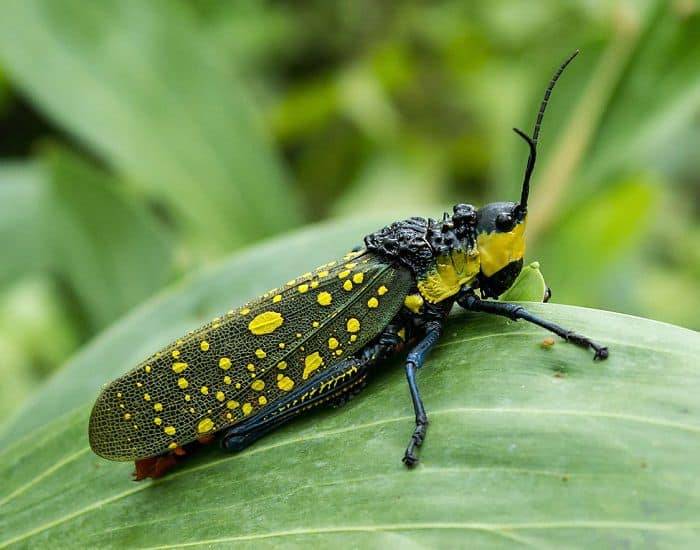Table of Contents
Those who like the idea of keeping an exotic-type pet might consider a grasshopper. Although an unusual choice, grasshoppers can make for a great pet as they are fascinating creatures to observe. Nevertheless, these insects do not live for very long.
How Long Do Grasshoppers Live?
A grasshopper will go through a number of stages during its life cycle: egg, nymph, and adult. These three stages typically last for no more than a year, so a grasshopper is not a pet that will be around for very long. In saying that, female grasshoppers can lay around three hundred eggs in a season, so if you wanted to, you could continually keep grasshoppers – as long as you have a male and female to begin with, of course.
will go through a number of stages during its life cycle: egg, nymph, and adult. These three stages typically last for no more than a year, so a grasshopper is not a pet that will be around for very long. In saying that, female grasshoppers can lay around three hundred eggs in a season, so if you wanted to, you could continually keep grasshoppers – as long as you have a male and female to begin with, of course.
Female grasshoppers lay eggs fertilized by a male during mating season. Upon laying the eggs, the female sprinkles them with a sticky substance that sets between 15 and 150 eggs in what is known as an egg pod. Female grasshoppers can lay up to 25 of these pods.
The eggs are usually laid around one to two inches underneath leaf litter or sand and will remain there for about ten months during fall and winter. The eggs typically hatch in late spring or early summer, at which time the nymphs emerge.
The nymphs look like adult grasshoppers but lack wings and reproductive organs when they first hatch. Nymphs go through five substages before reaching maturity (adulthood). Each substage is known as an instar and during each stage the skin is shed (a process known as molting) and the wings are gradually grown. It usually takes between five and six weeks for nymphs to reach full maturity.
and reproductive organs when they first hatch. Nymphs go through five substages before reaching maturity (adulthood). Each substage is known as an instar and during each stage the skin is shed (a process known as molting) and the wings are gradually grown. It usually takes between five and six weeks for nymphs to reach full maturity.
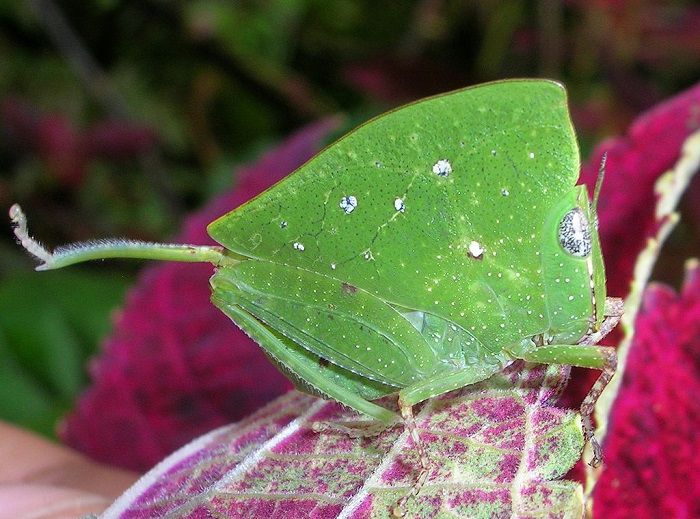
Leaf Grasshopper 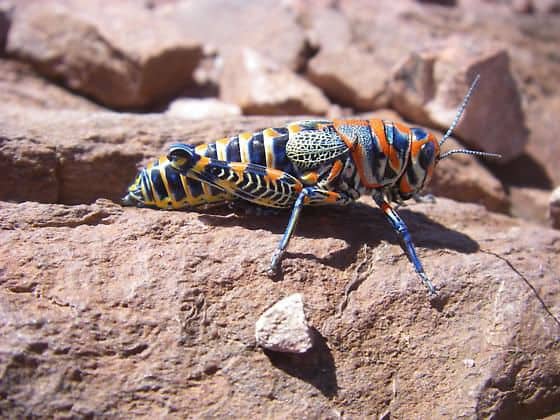
Rainbow Grasshopper
How Do You Keep Grasshoppers Alive?
If you have found grasshoppers near to your home in early summer, the chances are that these are nymphs or very young adults, meaning that you could consider keeping them as pets.
To keep grasshoppers alive and healthy for the duration of their life, you will need to take a few steps. Grasshoppers should be kept in a glass or plastic container with a secure lid that has holes for ventilation. If you want to try breeding the grasshoppers, you will need to be sure that there is a male and a female present. You can tell a female grasshopper by the four sharp points at the back of the abdomen (which are for laying eggs). One thing to be aware of is that if you have more than one male grasshopper in a tank, they may fight if there is not enough food available.
To provide the best environment for the grasshoppers, ensure there is sufficient space for them to jump about in as this is something that they like to do in their natural habitat. A five-to-ten-gallon terrarium is usually a good starting size.
Place a substrate at the bottom of the tank in which the female can lay her eggs. Suitable choices are sand, coconut fiber, leaf litter, or even dry oatmeal flakes. You will only need a depth of one-to-two inches. Grasshoppers also like having places to sit and to jump to and from, so a few twigs in the tank will make it a more enjoyable environment.
Providing sufficient heat and light will also help to keep grasshoppers healthy. They will thrive in a warm, dry environment, so a heat mat or heat bulb might be something worth investing in. The temperature of the tank should be set to between 77F and 95F. However, avoid placing the tank in direct sunlight as this can result in overheating.
Grasshoppers enjoy eating grass, so you could collect grass from areas near to your home. If the grasshopper does not like the grass provided, or if it is deemed to be harmful to them in some way, it will not eat it. You could also provide leaves for it to try.
Although grasshoppers are small, they do eat a lot so you will need to provide food every day. You might be surprised to know that these insects can eat up to sixteen times their own body weight in food. Also, note that grasshoppers will fight over food, so if you have more than one insect in the tank, you will need to provide even more food.
As grasshoppers get their water from the food, spray leaves and grass with water before placing it in the tank. It is best not to spray the terrarium with water though as grasshoppers do not thrive in humid environments.
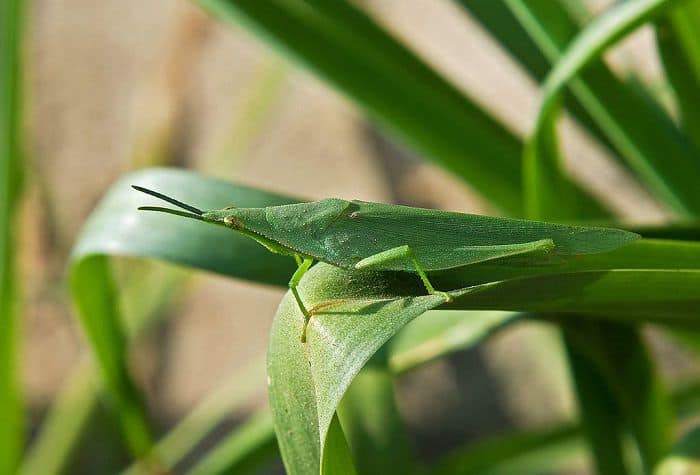
Tobacco Grasshopper 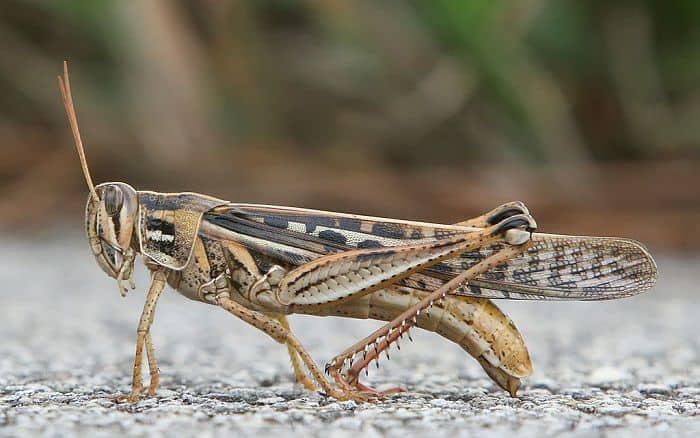
American Bird Grasshopper
Why is My Grasshopper Not Moving?
It is important to remember that grasshoppers do not live for very long. In fact, an adult grasshopper that has lived for five months after reaching full maturity could be considered old. If your grasshopper has been around for a number of months and has stopped moving, it could be that it is coming to the end of its life.
However, it might be the case that the temperature of the terrarium is too cold. As already mentioned, grasshoppers like warm environments so while it is okay for the temperature to drop as low as 60F at night, you need to ensure that daytime temperatures are much higher. A grasshopper that becomes too cold will become lethargic or stop moving. It could even get so cold that it dies.
How to Save a Dying Grasshopper?
We are often asked this question, and it is mainly from those who have found what appears to be a dying grasshopper near to their home. Those who pose this question often do so because they do not realize that these insects do not live for very long.
Adult grasshoppers in the wild rarely live through the winter unless they are in warm climates. The female will lay her eggs during midsummer and which will not hatch until the following spring or early summer. By this time though, the adult grasshoppers from the previous mating season will have died.
Basically, if you have found a dying grasshopper, there is not much that you can do to save it.
Why Did My Grasshopper Die?
A sudden drop in temperature can result in death for a grasshopper. If your grasshopper has died suddenly then it is worth looking at your setup to ensure that all is working as it should. If you are using a heat pad or bulb for artificial heat, it could be the case that something has malfunctioned.
Remember however that grasshoppers do not live a long life and some will die naturally sooner than others.
Photo Credits:
- Featured Image (Spotted Grasshopper): Crisco 1492
 – This file is licensed under the Creative Commons
– This file is licensed under the Creative Commons Attribution-Share Alike 3.0 Unported
Attribution-Share Alike 3.0 Unported license.
license. - Rainbow Grasshopper: Stellarkid
 – This file is licensed under the Creative Commons
– This file is licensed under the Creative Commons Attribution-Share Alike 3.0 Unported
Attribution-Share Alike 3.0 Unported license.
license. - Leaf Grasshopper: L. Shyamal – This file is licensed under the Creative Commons
 Attribution-Share Alike 2.5 Generic
Attribution-Share Alike 2.5 Generic license.
license. - American Bird Grasshopper: Tom Friedel
 – This file is licensed under the Creative Commons
– This file is licensed under the Creative Commons Attribution 3.0 Unported
Attribution 3.0 Unported license.
license. - Tobacco Grasshopper: Joydeep
 – CC BY-SA 3.0
– CC BY-SA 3.0

